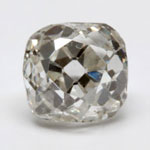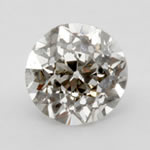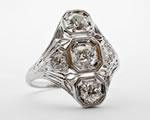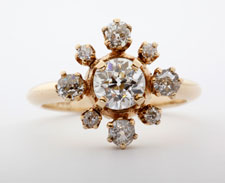 Old Cut, New Cut-It's All about Diamonds
Old Cut, New Cut-It's All about Diamonds
With suits or hairstyles, cut is just a matter of fashion. A dated haircut might be an embarrassment. But with diamonds, cut affects valuation.
We've said many times that cut accounts for about half the value of a diamond. A look at the history of diamond cutting will show why this is so.
Gem cutters in the Middle Ages had very basic tools, so gems had very basic shapes. Diamond workers would cleave the stone along its natural planes, using a hammer-and-chisel approach, making the sides as smooth as possible. Since diamonds typically grow in 8-sided crystals, what resulted was the “point cut” diamond.
Early Diamond Cuts |
||
 Point Cut |
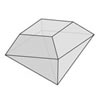 Old Mine Cut |
 Old Single Cut |
Such diamonds would look dull by today's standards. They'd have none of the sparkle and brilliance we associate with diamonds. In fact the table cut, developed in the 15th century, is said to have made diamonds set in jewelry appear black-but this was OK since at that time diamond was valued for its extreme hardness. For jewelry, colored gems such as ruby and sapphire were far more popular-but then again, all red stones were called rubies and all blue ones were called sapphires!
Technology still had a long way to go before cutters could take advantage of diamond's clarity and transparency to show off the stone's beauty.
Old Mine cut diamonds, popular in the 1700s, were basically rounded off squares. Diamonds were rounded by bruting-rubbing two diamonds against each other-a process that might take weeks of work on a single diamond. Later this procedure was mechanized. Old European, popular in the 1800's, was much more round and is a forerunner of the modern Round Brilliant cut.
By the late 19th century, changes were happening quickly. Mechanical saws allowed cutting large rough into smaller pieces. This meant that, instead of just grinding away any excess, cutters could saw the rough neatly into two pieces to produce two diamonds.

Mathematicians developed gauges for measuring precise angles. The science of optics began exploring the influence of cutting angles on the diamond's appearance.
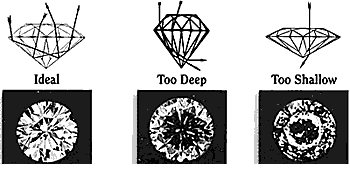
Jewelers recognized that “scientific cutting” could produce a diamond that reflected light back to the eye from many surfaces, greatly increasing the gem's sparkle and brilliance. In a well-cut diamond, light is refracted back through the top of the gem to the eye. In a poorly cut stone, light is lost and the diamond has dark spots.
Traditionally, gemstones were worked to keep the diamond large, to minimize waste. But the new scientific analyses revealed that, to produce a diamond with brilliance and fire, a lot of stone has to be cut away.
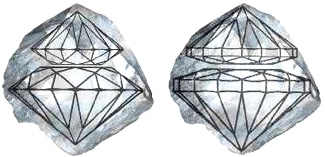
In this illustration, the left image shows two well-proportioned gems cut from diamond rough. The right image shows how the same piece of rough could yield two larger stones (greater carat weight), but they would be poorly proportioned and much less attractive.
Today the ideal proportions for Round Brilliant Cut diamonds have been standardized. A diagram and description of this cut appear on the reverse of the JISO 78/79 jewelry appraisal form.
Valuation of “old” and “new”
Old-cut diamonds, such as Old European Cut and Old Mine Cut tend to look dark and “heavy.” These gems are less desirable and have a lower valuation than a well-cut diamond of comparable weight.
Important Note: It's not only old diamonds that are cut to preserve weight.
Bargains! Unfortunately, even in contemporary jewelry a large percentage of diamonds are still poorly proportioned, because carat weight is what consumers value. “Bargain” prices and comparisons based on carat weight alone lead many customers to pay more than the jewelry is worth.
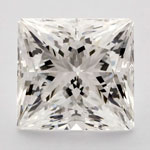 Princess Cut The Princess Cut is a popular modern cut that preserves carat weight. A major shortcoming of this squarish shape is that the corners of the stone are vulnerable to chipping. Some insurers consider this vulnerability an inherent vice and do not insure princess cut stones unless the setting protects the corners.
Princess Cut The Princess Cut is a popular modern cut that preserves carat weight. A major shortcoming of this squarish shape is that the corners of the stone are vulnerable to chipping. Some insurers consider this vulnerability an inherent vice and do not insure princess cut stones unless the setting protects the corners.
“Old” Is In Not all old-cut gems are old. As early styles become more popular, contemporary jewelry will mimic them. The same caveats apply here as with all fads: what is expensive when it's in fashion can quickly drop in value when it becomes passé.
In Summation: It is always crucial for the insurer, and the insured, to have an appraisal detailing the cut proportions (as well as the other 4 Cs: clarity, color and carat weight). It bears repeating:
Up to 50% of a diamond's valuation
is based on cut.
FOR AGENTS & UNDERWRITERS
For diamond jewelry, be sure to have a detailed appraisal that includes cut information. Preferably, the appraisal is on JISO 78/79 form and is prepared by a Certified Insurance Appraiser™.
Some older styles, such as Old Mine Cut and Old European Cut diamonds, are available today from internet retailers. They appeal to those interested in an antique look.
Insuring older pieces, such as antique jewelry or inherited jewelry, calls for extra precautions. Cut quality, styles that are out of fashion, and imitation diamond mixed in with quality gems (often done in earlier jewelry) can affect valuation. Antique jewelry should be appraised by a jeweler familiar with such jewelry and its market.
FOR ADJUSTERS
When pricing a replacement, give the replacing jeweler all descriptive information from the appraisal and other documents. Do not give the valuation. The replacement price should be based on the quality of the jewelry (as described on the appraisal and lab report), not on your limit of liability or on the original purchase price.
Compare the description on the gem lab report with the description on the appraisal. Compare the valuation with the purchase price, if available. When a large settlement is at issue, it could be worthwhile to consult a jewelry insurance professional to help determine the true quality and value of the jewelry and avoid a large overpayment
On a damage claim for a high-priced diamond, always have the piece examined by a qualified gemologist, such as a Certified Insurance Appraiser™, to determine whether the diamond is natural or synthetic (and to be sure its qualities are as stated in the appraisal).
©2000-2025, JCRS Inland Marine Solutions, Inc. All Rights Reserved. www.jcrs.com

